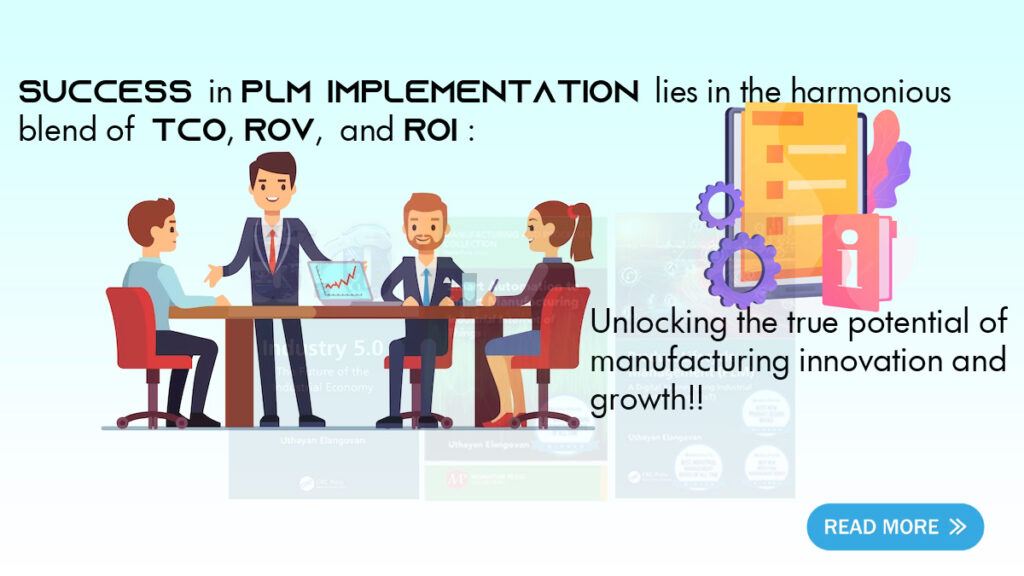A Buyers Guide: Considering TCO, ROV, and ROI (Total Cost of Ownership, Return on Value, and Return on Investment) in PLM Implementation for Manufacturing Enterprises

Introduction:
Implementing a Product Lifecycle Management (PLM) system is a significant decision for manufacturing enterprises. It involves careful consideration of various factors, including the total cost of ownership , return on value, and return on investment. In this buyers guide, we will explore the different ways these factors are considered during PLM implementation, providing examples to help you make informed decisions that drive success in your organization.
Total Cost of Ownership:
TCO refers to the complete cost associated with implementing and maintaining a PLM system throughout its lifecycle. It encompasses both direct and indirect expenses. Here are key considerations for evaluating TCO:
a. Software License and Implementation Costs:
Evaluate the upfront costs of PLM software licenses, customization, and implementation services. Look for solutions that align with your budget and offer flexibility for future scalability.
b. Infrastructure and Hardware:
Determine the hardware and infrastructure requirements necessary to support the PLM system. Consider the costs of servers, storage, networking, and any additional equipment needed for optimal performance.
c. Maintenance and Support:
Take into account ongoing maintenance and support costs, including software updates, bug fixes, technical assistance, and training. Ensure that the PLM vendor provides reliable support services to minimize disruptions and downtime.
d. Integration:
Assess the integration costs of connecting the PLM system with existing enterprise systems such as Enterprise Resource Planning (ERP) or Customer Relationship Management (CRM) software. Integration challenges should be considered during the evaluation process.
Example: Manufacturing Company NeelSMARTEC estimated their PLM TCO by accounting for software licensing fees, implementation costs, hardware upgrades, annual maintenance fees, and integration expenses. This comprehensive approach helped them avoid unexpected financial burdens and ensure a smoother implementation process.
Return on Value:
ROV measures the tangible and intangible benefits a PLM system brings to an organization. Evaluating ROV helps assess the value derived from PLM implementation. Consider the following factors:
a. Productivity and Efficiency Gains:
Analyze how PLM implementation can streamline product development processes, enhance collaboration, reduce errors, and improve time-to-market. Assess potential productivity gains through automation and optimized workflows.
b. Improved Quality and Compliance:
Evaluate how PLM can enhance product quality by ensuring consistency, traceability, and adherence to industry regulations and standards. Consider the impact of improved quality on customer satisfaction and brand reputation.
c. Enhanced Innovation and Time-to-Value:
Assess how PLM can foster innovation by enabling efficient idea management, design reuse, and product portfolio optimization. Evaluate the potential for accelerated time-to-value by bringing products to market faster.
Example: Manufacturing Company NeelSMARTEC measured ROV by analyzing the reduction in product development cycle time, decreased rework, improved collaboration among teams, and increased compliance adherence. These tangible benefits resulted in significant cost savings and improved customer satisfaction.
Return on Investment:
ROI determines the financial gain achieved from PLM implementation by comparing the investment with the monetary benefits realized. Key considerations for calculating ROI include:
a. Cost Savings:
Identify potential cost savings resulting from reduced scrap, rework, and warranty claims. Evaluate how PLM can optimize inventory management, minimize material waste, and improve procurement processes.
b. Revenue Increase:
Assess the impact of PLM on revenue growth through improved product quality, accelerated time-to-market, and increased customer satisfaction. Consider how PLM can facilitate the introduction of new products and variants.
c. Competitive Advantage:
Analyze how PLM implementation can differentiate your organization from competitors by fostering innovation, enabling faster response to market demands, and facilitating product customization.
Example: Manufacturing Company NeelSMARTEC achieved a positive ROI by calculating the cost savings from reduced scrap, improved inventory management, and accelerated time-to-market. The increased revenue resulting from higher product quality and customer satisfaction contributed to their overall ROI.
Conclusion:
When considering PLM implementation in a manufacturing enterprise, it is essential to evaluate the TCO, ROV, ROI. By considering these factors and using the examples provided, you can make informed decisions that align with your organization’s goals and drive successful PLM implementation. Remember, a thorough analysis of these factors will help you maximize the benefits of PLM while minimizing risks and uncertainties.
Take your manufacturing operations to the next level with Neel Smartec! Whether you’re a small to medium manufacturer or a discrete manufacturer, we have the perfect PLM solution for you. Explore OpenBOM for small to medium manufacturers and PTC Windchill for discrete manufacturers. Don’t miss out on the power of PLM! For more information and insights on PLM, check out our comprehensive publication. Connect with us today!

